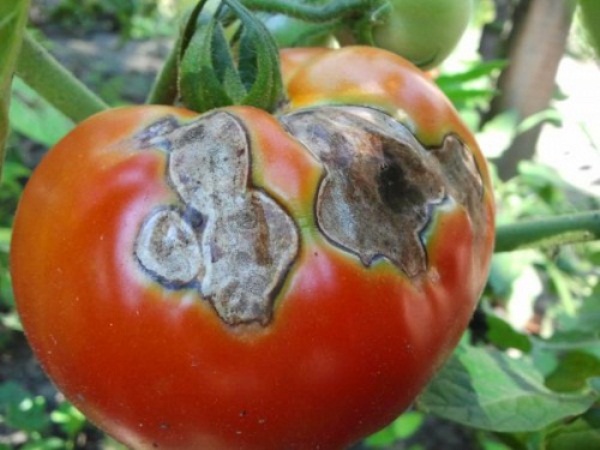Tomatoes are successfully grown in various regions of our country. A variety of varieties and hybrids helps to choose the most suitable look for the conditions. However, there are situations when the plants become infected, get sick. Therefore, you need to be prepared for a similar situation, to know how to deal with the problem. In our article we will examine in detail one of the diseases of tomatoes - gray rot, as well as how to treat it.
Table of contents
What is rot on tomatoes
Rot - a dangerous fungal infection that affects various vegetable crops, including tomatoes. Disposal of plants from it - the process is time consuming, long. Its success is largely determined by the timeliness of the protective measures taken and the correct diagnosis of the disease.
How does the disease begin?
The disease begins with the defeat of the injured stem of the plant. Spots of a gray-brown shade form on the affected areas. Then they sprout over the stalk over 5 daysgird him. Then the stain brightens, stripes appear in its place. In the first week there is no gray mold fungus on the spot. The disease develops in the stem. Part of the stem dies off, through which the plant’s nutrition stops, it fades. Yellow leaves above the affected area.
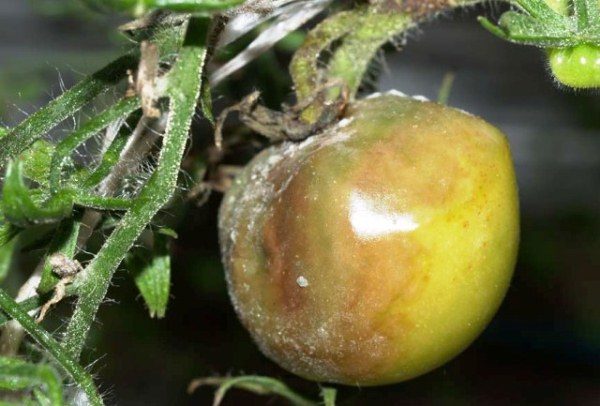
Signs of gray mold are similar to manifestations of necrosis of the core. But there is a significant difference. With necrosis, the whole plant will wither, and with gray rot, only part of the plant that lies above the affected area will wither. Most importantly, through 7-10 days a characteristic ash-gray bloom appears on the spot from the moment of defeatby which you can uniquely identify the disease.
Optimal conditions for the development of the disease - high humidity. It develops during the formation of the fruit, affecting all the aerial parts of the plant. At the beginning of infection (of individual plants), the infection spreads relatively slowly.. But upon the occurrence of favorable conditions - quickly infects neighboring plants. With mass distribution can destroy most of the crop.
Types of rot
There are several diseases united by one name - rot.
Gray rot
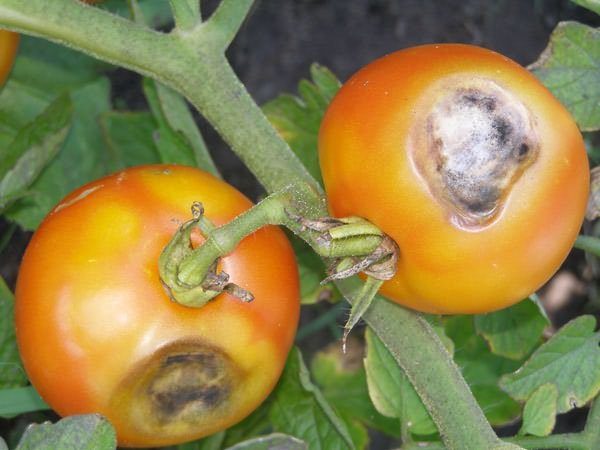
Fungal disease. His appearance provokes Botrytis cinerea Pers. The disease can affect fruits grown both in greenhouse conditions and in the open field. For its distribution, high humidity, unbalanced nutrition (excessive nitrogen fertilizers) are needed. External manifestations of the disease:
- rotting fruit grayish tint;
- characteristic fluffy raid;
- leaf spot;
- affected plant stem.
The disease is transmitted from plant to plant.. Having become infected, they rapidly fade and die. Upon detection of rotten fruit, they must be collected and destroyed (burned or buried), but in no case be left in the compost heap.
Brown rot
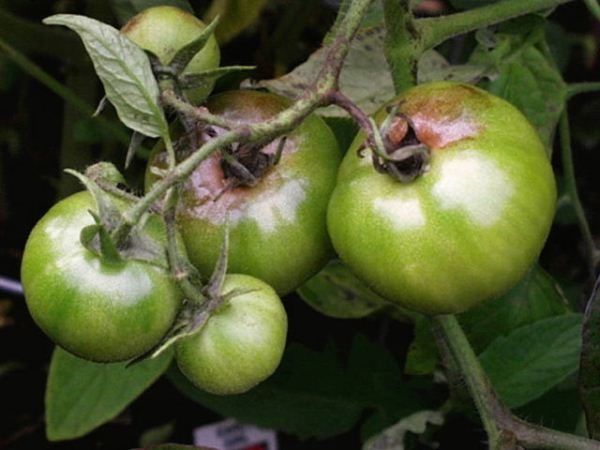
Brown rot is also called fomozom. This disease is very common. Place of destruction of the plant is located near the stem. The fungus enters the fetus due to the violation of its integrity due to rain or wind. Outwardly, it is not always possible to reliably determine the disease, since on the fruit can be only small brown spots. However, the tomato fruit will be completely rotted. The disease can provoke plant nutrition with fresh manure, which is highly undesirable for them.
White rot

The disease is caused by a pathogen. Sclerotinia sclerotiorum. Damage is caused to the crop during storage. The primary sources of the fungus are compost and soil.
Signs of:
- wateriness and discoloration of the leaves of the plant;
- white coated fruit.
Additional conditions for the occurrence of the disease are considered: soil that is not disinfected, low temperature in the greenhouse (below 18ºС) during planting, high humidity.
Vertex rot on tomatoes
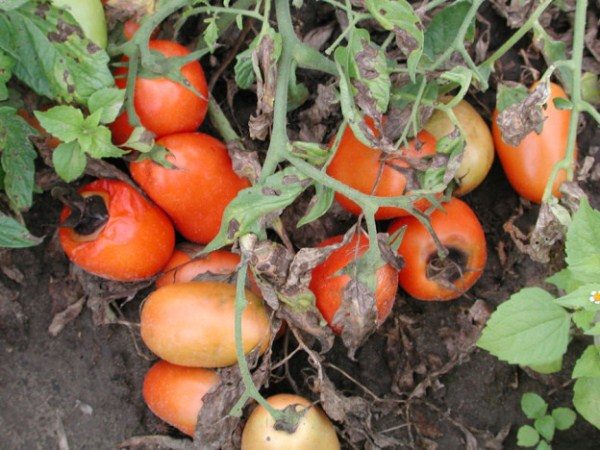
Top rot affects tomatoes that are grown in greenhouses and greenhouses. The disease spreads very quickly, can cause great damage to the crop in a short time. The initial symptoms are noticeable even on immature fruits.: watery spots are much darker than fruit. Then the stain becomes brown, the fruit shrivels and disappears. Fungi can develop at the site of rot, but the disease does not have a fungal nature of origin. Main reasons:
- aridity;
- insufficient watering;
- salty soil;
- calcium deficiency or its high content in fertilizers.
Rhizoctoniosis or root rot
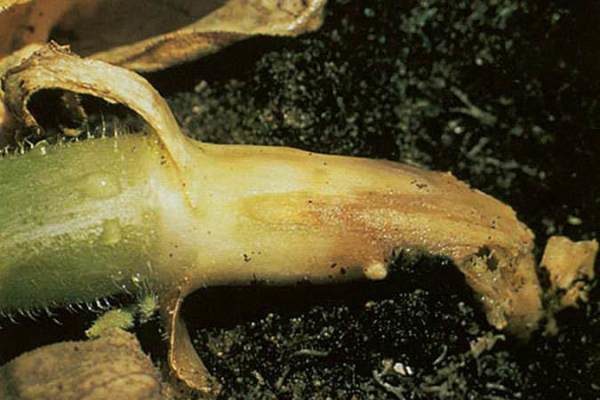
Often found root rot of tomatoes, which is also called the black leg. It is caused by a complex of pests: phytopathogenic fungi: Rhizoctonia, Fusarium, Pythium, Phytophthora, or the phytopathogenic bacterium Erwiniacarotovora. Tomatoes that grow in greenhouses using a substrate are particularly susceptible to disease. This disease can kill up to 70% of young plants.
Main features:
- softened root neck;
- its blackening;
- the appearance of constriction.
After the appearance of these signs, the plant fades and dies.Tomato infection conditions include: high level of air humidity, excessive watering of the substrate, imbalance of top dressing with mineral substances.
Where does rot on tomatoes come from
Rot - a fungal disease. In order to avoid its unpleasant consequences, it is necessary to know why it appears. Experienced gardeners call a number of adverse conditions under which the appearance of different types of rot is possible.

The most common include:
- unsterilized soil or substratein which spores of pathogens of various pathologies have been preserved will provoke a massive infection of plants in greenhouse structures;
- use of untested seeds, especially often own;
- failure to comply with the humidity regime in the greenhouse, excessive accumulated moisture when watering plants will lead to fungal infections of vegetable crops;
- no less dangerous and insufficient wateringbecause in this case, the plant lacks nutrition, it weakens, it becomes easily affected by all sorts of diseases, including fungal diseases.
Preparations against gray rot
Treatments for gray rot of tomatoes are well developed. However, they are often beginning to use too late, which significantly affects the efficiency. The most frequently taken measures are not effective enough due to incorrect diagnosis of pathology..
To protect plants should be an integrated approach. The most important is the timely detection of primary foci of the disease. Particular attention should be paid to the careful handling of plants.: it will reduce the likelihood of wounds through which the pathogen easily infects tomatoes.
During the vegetative period, it is necessary to regularly examine the plants in order to identify the first signs of gray rot. Particular attention should be paid to this work when tearing off the leaves in wet weather.. If you find foci of disease - coat tomatoes with fungicide paste. General processing of plants is carried out if there was no thorough plastering of the fruit at the time of the appearance of the disease. In case of continuous treatment, experienced gardeners recommend the use of Topsin M, Bayleton, Euparen multi.
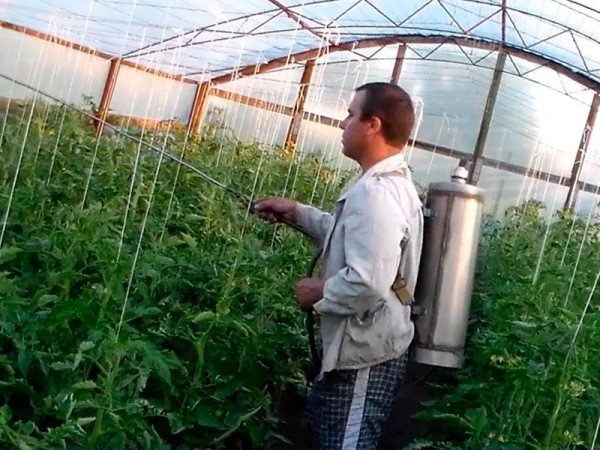
Growth regulators. The use of Humate sodium during the growing season significantly reduces the likelihood of development and mass distribution of gray rot.
Biological means. Preventive treatment of plants with Trichodermine suspension, especially after cutting leaves, minimizes the development of repeated foci of infection. The same purpose is the coating of wet spots with a suspension of Trichodermine, Glyocladin. The method is time consuming, but very effective. It is also recommended to spraying Trichodermine with new cuts of leaf stalks during their mass removal. Treat the tomatoes during the day to allow them to dry.
Preventive actions
Any disease is easier to prevent than to cure. This statement fully applies to tomatoes. Compliance with the agrotechnical requirements for growing tomatoes will help grow, harvest and maintain a decent crop. What do you need to pay attention to?
- Balance mineral fertilizers.
- Accuracy of the treatment of plants. Broken branches can cause disease.
- Soil mulchingthat will affect its properties and will not allow to dry.
- Protection against hypothermia during planting.
- Protecting plants from inappropriate weather conditions (landing in greenhouse conditions).
- Observance of the optimal distance between plants for the sufficiency of obtaining useful substances by them.
- Timely and thorough soil disinfection.
- Selection and seed treatment.
Conclusion
Any kind of rot is very dangerous. She is able to completely destroy the grown crop. Little of, rot is easily transmitted in a short time from one crop to another. To avoid unpleasant consequences, take care to prevent this disease.
